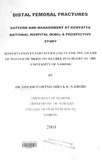| dc.contributor.author | Oduor, P. Owino | |
| dc.date.accessioned | 2013-05-24T06:44:01Z | |
| dc.date.available | 2013-05-24T06:44:01Z | |
| dc.date.issued | 2004 | |
| dc.identifier.citation | Master of Medicine Degree in Surgery if the University of Nairobi, 2004 | en |
| dc.identifier.uri | http://erepository.uonbi.ac.ke:8080/xmlui/handle/11295/25096 | |
| dc.description.abstract | Background.
Distal fractures of the femur affect mainly the young and economically
productive age group, hence socioeconomic implications for the patient and
their dependants.
Objectives.
The immediate objective of this study was to determine the presentation,
management and outcome of patients with these fractures at Kenyatta
National Hospital, the teaching and referral hospital located in Nairobi, the
capital city of Kenya. The ultimate objective was to provide information
that will assist policy makers and surgeons improve patient care and hencereduce the morbidity from this condition.
Study design and setting.
This was a prospective study conducted from August 2003 to January 2004.
A total of seventy two patients met the admission criteria and were recruited
into the study by convenience sampling. They were followed up in the wards
and later in the outpatient clinics. Information on the demographic data,
pattern of the injury, management offered and the outcome was gathered and
the data obtained processed and analysed.
Results.
The mean age was thirty six years. Seventy five per cent were males and
thirty nine per cent were in active employment. The most common causes of
trauma were road traffic accident (42%) and gun shot (250/0). Associated
injuries were common (66.70/0 of the patients).
Plain X-ray was the main diagnostic investigation used. Sixty nine per cent
had type A, eight per cent type B and twenty two per cent type C fractures
according to AO classification. Thirty one per cent had open fractures.
Most of the patients were offered conservative treatment in the form of
skeletal traction and only 5.50/0 had operation with no initial traction. The
overall mean hospital stay was fifty five days. The means for different
treatment groups of patients were 49 days for conservative group, 67.5 days
for those undergoing both treatments and 37.5 days for operation - only.
Complication rates for different groups of patients were 50% for operation -
only, 1000/0 for conservative - only and 600/0 for both treatments. The most
common complications were knee stiffness (74.2%), mal-union (30.60/0) and
infection (20.8%).
Conclusion and recommendation
This study revealed that most patients with this injury underwent
conservative treatment with very high complication rates. Operative
treatment is the most cost effective form of management of distal femoral
fractures and is thus recommended. | en |
| dc.language.iso | en | en |
| dc.publisher | University of Nairobi | en |
| dc.title | Distal femoral fractures pattern and management at Kenyatta national hospital (KNH): a prospective study | en |
| dc.type | Thesis | en |
| dc.description.department | a
Department of Psychiatry, University of Nairobi, ; bDepartment of Mental Health, School of Medicine,
Moi University, Eldoret, Kenya | |
| local.publisher | School of Medicine | en |

